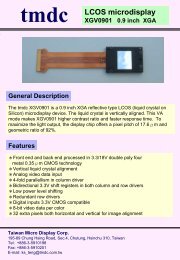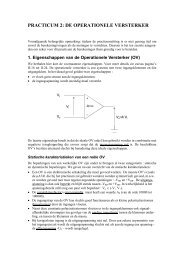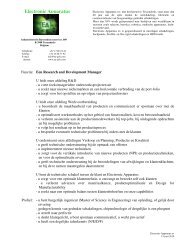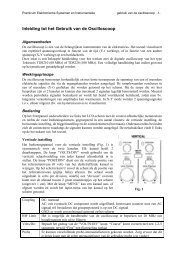Design of LCOS Microdisplay Backplanes for Projection Applications
Design of LCOS Microdisplay Backplanes for Projection Applications
Design of LCOS Microdisplay Backplanes for Projection Applications
Create successful ePaper yourself
Turn your PDF publications into a flip-book with our unique Google optimized e-Paper software.
Chapter 2: Constraints from lcos technology CH2 - 41<br />
Chapter 2: Constraints from lcos technology<br />
What constraints must be dealt with <strong>for</strong> the design <strong>of</strong> a micro-display backplane?<br />
This chapter describes the technological boundary conditions to live with; it is a<br />
collection <strong>of</strong> crucial background in<strong>for</strong>mation. The topics cover panel assembly and<br />
IC processing technology.<br />
A first section “a designer’s perspective” summarizes the lcos product chain. The<br />
second section “lcos cell assembly technology highlights” discusses the constraints<br />
from cell assembly technology. The third section discusses constraints directly<br />
related to the Si processing itself. Stitching takes a particular place with the<br />
processing <strong>of</strong> very large dies.<br />
2.1 An IC designer's perspective<br />
2.1.1 A system flow and global constraints<br />
A simple organigram partitions an lcos system into three separate sub-systems<br />
(figure 2-1). The optical and electronic subsystems strongly relate to one another.<br />
The mechanical sub-system serves the purpose <strong>of</strong> providing mechanical robustness,<br />
along with a marketing ‘body’. It is not <strong>of</strong> primary concern here.<br />
Lcos panels actually <strong>for</strong>m a bridge between the first two subsystems. The<br />
optimization <strong>of</strong> the optical sub-system is not treated in this thesis; rather a portion <strong>of</strong><br />
the electronic sub-system is focused on. It is however impossible to consider the<br />
design <strong>of</strong> an lcos backplane chip without considering the relationships to the other<br />
components (in casu: the interface electronics and the optical engine architecture).<br />
This also reflects in the impact some global constraints have on both sub-systems.<br />
• general per<strong>for</strong>mance specifications (pixel count, frame rate, power…)<br />
• optical engine architecture (color architecture, component size…)<br />
• LC effect (pixel architecture, IC voltage requirements…)<br />
Electronic sub-system:<br />
“micro-display module”<br />
<strong>LCOS</strong> system:<br />
“<strong>LCOS</strong> RPTV, <strong>LCOS</strong> FP…”<br />
Optical sub-system:<br />
“optical engine”<br />
Mechanical sub-system:<br />
“the apparatus”<br />
Figure 2-1 : a simple organigram <strong>of</strong> a <strong>LCOS</strong> system<br />
CH2 - 41











